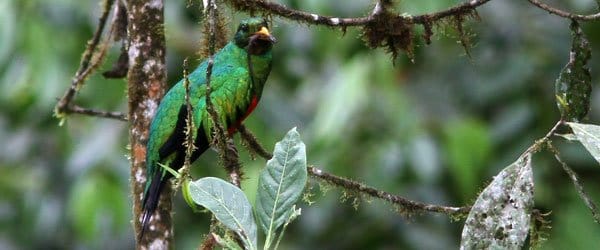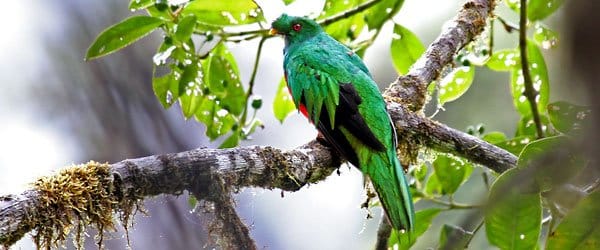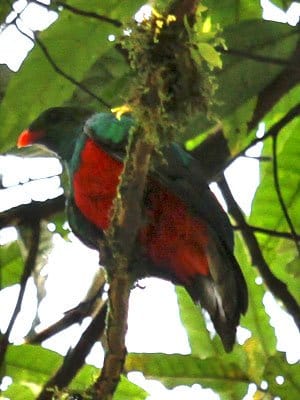Ecuador has three types of Quetzals, one in the Amazon basin and two in the east and west slopes. The Quetzals in the slopes have a very limited altitudinal range restricted to altitudes above 1500 meters and below 2500 meters. These large and beautiful birds are very difficult to find because they sit motionless during their rest periods; therefore they are often heard more than seen. But when you see them it is a beautiful sight. In most cases I have found them only when they are moving or by locating them while they call. Also I have found them near feeding trees where other birds are feeding.
This Golden-headed Quetzal was photographed at Recinto 23 de Junio known for the Long-wattled Umbrellabird. Once you reach 23 de Junio there is a road that leads to higher ground where I have seen as many as four Quetzals in a couple of hours.
Golden-headed Quetzal (Pharomachrus auriceps)
The next photo is of the Crested Quetzal which is more difficult to find. This beautiful specimen was photographed at Refugio Paz de las Aves which is famous for their hand-feed set of Antpittas including: Giant Antpitta (Grallaria gigantean), Yellow-breasted Antpita (Grallaria flavotincta), Moustached Antpitta (Grallaria alleni), and Ochre-breasted Antpitta (Grallaricula flavirostris).
Crested Quetzal (Pharomachrus antisianus)
The Pavonine Quetzal lives in the Amazon Basin all the way up to 600 meters. It is the only Quetzal found in the Amazon but I have not obtained good pictures of this bird. The picture below was obtained at Gareno Lodge which is now famous for being the easiest place to find the Rufous Potoo.
Pavonine Quetzal (Pharomachrus pavoninus)














Awesome! Everybody loves quetzals.
Quetzals are such amazing birds! How lucky you are to live in a country with three different species. Congrats on getting a shot of the elusive Pavonine!
This post reminds me of a great book I read many years ago and imagine others that frequent 10000birds would also enjoy. It is a sort of political ornithology of Central America in which the main character is traveling about the region hoping to see the Resplendent Quetzal. The book is called “Bird of Life, Bird of Death” by Jonathan Evan Maslow…check it out if you like birding travelogue natural history type writing.
Beautiful birds!
What sound do they make?
@Mike: Yes, I was very happy when I finally saw the Pavonine Quetzal to complete the simple trio that live in our habitat.
@Pat: Thanks, as always you are very knowledgeable of the South American birds.
@YourBirdOasis: Thanks, I hope to read this book sometime.
@Clare: It is a very simple whistle with only a couple of notes; it looks a lot better than it sounds. You can hear many bird sounds at http://www.xeno-canto.org/
I can hardly wait to see these (well, if I’m lucky!). I’ll be in Ecuador during August, so please keep these posts coming, Renato. :^)
Wait, I have seen 2 out of Ecuador’s 3 quetzals? Renato, I have to get back to Ecuador for the clean sweep!
I have seen flocks of Resplendent Quetzals a couple of times at Cerro de la Muerte in Costa Rica. They are easy to see there in the springtime but I really never gave it a thought that there might be other types of quetzals. How many different types are there?
Thanks for posting these photos.
@Pohanginapete: Thanks, wish you the best and don´t hesitate to contact me if you have any questions about birding in Ecuador.
@Corey: Yes, I am looking forward to round 2.
@Jose: I found six species listed on: http://en.wikipedia.org/wiki/Quetzal
Six quetzal species. Great! Thanks for the info.